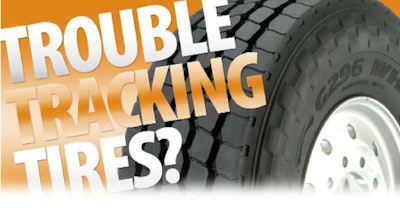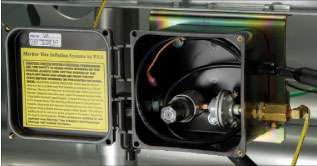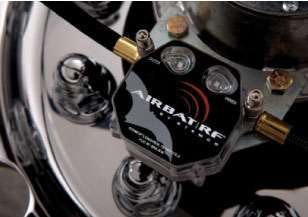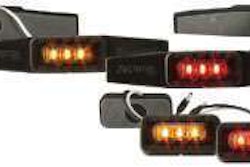
For most fleets, the top three costs directly related to keeping trucks on the road are labor, fuel and tires. Fuel and tires are consumable items, which means fleet managers have to find ways to extend the service life of each before replenishing or replacing them.
Fuel offers a straightforward proposition: Get your vehicle to go farther while burning less diesel. Tires, on the other hand, are a bit trickier. True, the longer you can extend tread life, the more miles you can log before replacement time rolls around. But tires are integral to fuel economy and the safety of the vehicle, the driver, the load and the motoring public. Tire failures are costly enough if all you have to deal with is downtime, towing fees and replacement costs. Start factoring in variables such as accidents involving your vehicle and others on the road, lost loads and injuries, and tracking and maintaining tire health takes on a whole new level of importance.
Drivers are your first line of defense in maintaining good tire condition on your trucks, tractors and trailers. Sharp eyes during daily pre- and post-trip inspections can go a long way toward avoiding premature failures and preventing accidents. But most drivers are concerned primarily with air pressure and will look only for tell-tale bulges at the bottom of the tire, indicating low pressure.
Some drivers take the time to whack their tires with an old ax handle or a hammer to check pressure – although most experts say this method does little to gauge tire pressure levels accurately. But even if a driver actually crawls under a truck and carries out a textbook pre-trip inspection, he only can check about a third of any tire’s surface area. So unless tire damage is present in the visible area or so severe that it simply cannot be overlooked, even potentially catastrophic tears, punctures or chunking can go unnoticed.
Technicians are your second line of defense. They typically look at tires in greater detail, inspecting both front and back sidewalls, as well as the entire tread area in detail. But technicians only see vehicles periodically; they can do little to prevent tire failure in day-to-day operations.
Ultimately, you need something more to protect your tires and help them live safe, long and productive lives while lowering your acquisition, repair and liability costs in the process. Luckily, today’s technology can help you do just that, thanks primarily to tire pressure monitoring systems. A wide variety of systems now exist that allow fleets real-time access to tire health information and asset management. These systems typically transmit data via wires, radio frequency identification (RFID), GPS, barcode labels or electronic chips and readers, which can be handheld or gate readers. Better yet, most of these systems are customizable and can be tailored to meet a fleet’s needs or for specific applications.
Conquering the Critical Six
One of the most appealing aspects of a tire condition monitoring program is that the benefits take effect almost immediately. “Installing a system can have a dramatic effect,” says Clif Armstrong, director of marketing for commercial vehicle tires for Continental Tire the Americas. The Technology & Maintenance Council estimates that for every 10 percent of underinflation, the tire’s tread can wear up to 16 percent faster, and that 90 percent of tire failures stem from improper inflation.
 The Meritor Tire Inflation System by P.S.I. monitors tire health, flashes appropriate warnings and counters a low-pressure situation by taking air from the tractor-trailer’s air system and inflating any tire that is registering low.
The Meritor Tire Inflation System by P.S.I. monitors tire health, flashes appropriate warnings and counters a low-pressure situation by taking air from the tractor-trailer’s air system and inflating any tire that is registering low.Doug Jones, customer engineering support manager for Michelin Americas Truck Tires, says tire damage can be reduced and tire life extended dramatically, depending upon the starting point of the program. A fleet with no tire management program beyond driver and technician inspections can see immediate improvement in what Michelin calls the “Critical Six” areas of on-highway tire management: low air pressure, high air pressure, missing valve caps, dual mismatch air pressure, dual mismatch height and irregular wear.
“Any fleet that can pay attention to these factors and act on them will see improvement in every one of them,” Jones says. “Improvement in each individual area translates into longer tire life and lower acquisition and repair costs.”
Government relations
For fleets seeking U.S. Environmental Protection Agency SmartWay certification and looking to squeeze every mile possible out of a gallon of fuel, tire monitoring becomes even more crucial. Tire manufacturers are focusing on tire durability as a way to extend tread life on tires with low rolling resistance.
“Fleets with tire condition monitoring systems will have a leg up in that area,” says Rick Phillips, manager of commercial sales for Yokohama Tire Corp. “They can reap the financial rewards from using fuel-efficient tires on their trucks and trailers and rely on a real-time, proactive tire condition monitoring system to extend tread life on those tires.”
The government is likely to force fleets’ hands: The Federal Motor Carrier Safety Administration will begin cracking down on truck, tractor and trailer tire conditions this fall with its Comprehensive Safety Analysis 2010 criteria. “Tires are widely regarded by FMCSA as fleets’ number-one maintenance concern,” says Frank Sonzala, executive vice president of Pressure Systems International. CSA 2010 will list all violations, even if there was no out-of-service condition and no citation issued. A fleet’s driver profile will list violations in seven safety ranking sections, including basic vehicle maintenance.
Under the new guidelines, any roadside inspection that lists a tire maintenance violation – such as underinflation, low air pressure, insufficient tread depth, cuts and damage, or missing tires altogether – will remain on the carrier’s profile for two years and the driver’s profile for three years. And under CSA 2010, the severity weight for tire violations under vehicle maintenance ranks higher than violations related to brakes and electrical systems. “It’s going to become increasingly important for fleets and individual drivers to have a firm grip on their tire maintenance procedures,” Sonzala says.
Passive or active?
There are many different approaches to tire condition monitoring – from relatively simple systems that trigger a dash-mounted alert light, to active inflation systems such as the Meritor Tire Inflation System by P.S.I., which has been adopted by several large fleets. Systems such as Bendix’s SmarTire, Advantage Enterprises’ PressurePro and TireStamp’s TireVigil TPMS monitor tire pressure while the truck is in operation.
Tire pressure monitoring systems typically rely on a truck or trailer’s air system to operate. Typically, a sensor on the wheel or valve stem, once activated, feeds information to a receiver. A warning is issued once a problem is detected, which can be as simple as a yellow light or as complex as an in-cab display that shows a full vehicle schematic for each tire position, giving location and pressure data for all tires. Using the vehicle’s telematics system, fleet managers can program the system to dispatch the alert or warning to any party it deems necessary, including the fleet dispatcher, maintenance department or even the tire dealer.
 Stemco’s Bat RF sensors include indicators that consist of an LED that blinks once per second when out of tolerance. These mount to the hubcap or lugnut, and their hoses connect to the tire valve stems.
Stemco’s Bat RF sensors include indicators that consist of an LED that blinks once per second when out of tolerance. These mount to the hubcap or lugnut, and their hoses connect to the tire valve stems.Active inflation systems such as the MTIS by P.S.I. not only monitor tire health and flash appropriate warnings but also work to counter a low-pressure situation by taking air from the tractor-trailer’s air system and inflating any tire that is registering low.
Truck air compressors produce much more air than is required for the proper function of the trailer brakes, Sonzala says; MTIS utilizes this excess air to inflate any tires that may be low. The excess air is routed from the trailer air brake system through a filter and then a regulator and flow switch in the control box, then through the axles and finally through a fitting in the hubcap called a Thru-T. Hoses attached to threaded fittings on the Thru-T and valve stems allow the air to complete its journey to the tire.
Sophisticated inspections
In addition to onboard systems that either monitor or inflate, other systems simplify monitoring, collection and management of vehicle tire pressures using standard inspection procedures.
An inspector – usually a technician – uses handheld fleet check tools to determine air pressure and temperature. This information is relayed through a personal data assistant or smartphone via Bluetooth technology into the tire monitoring software. At the end of the fleet check, the total program is loaded into a database that allows the fleet to run reports on many different aspects of the tire maintenance program they have in place. Fleets can tailor the input and output to see exactly the reports they feel are necessary to best manage costs.
Stemco’s approach is to use a series of active RF components that can be customized for individual fleet needs, providing real-time data for tire inflation, fuel consumption, mileage and asset identification. The system allows the user to easily and conveniently monitor equipment and manage operating costs from a computer. The sensors include indicators that consist of an LED that blinks once per second when out of tolerance; these mount to the hubcap or lugnut, and their hoses connect to the tire valve stems.
Your tires may look fine at a glance, but busy drivers and technicians can’t catch everything that may be wrong with them.
Monitoring hardware available with the Bat RF includes a handheld portable reader, a fixed reader that might be mounted in a gate post, a mobile reader designed to interface with third-party vehicle tracking systems, and an In-Cab alert. The data is used to discover leaking tires and analyze tire performance, calculate miles per gallon, identify mismatched duals and support warranty claims. All data is available 24/7 via secure Web access.
The big picture
Some technologies don’t directly monitor current tire condition, but they do make it much easier to keep track of tires in a fleet. Thomas Bielicki, president of Tire-Track, says his company’s permanent all-rubber barcode label serializes a tire, allowing fleet managers access to a wealth of information that paints a highly accurate picture of the fleet’s tire use profile.
Bielicki says fleets using the Tire-Track system can determine how many tires are lost in the course of a year; which tires or tire brands provide the lowest cost per mile for specific applications; if different tires perform better in different applications within the fleet; dealer service comparisons; if a retread casing is returned to the fleet; and if a retread came from another fleet.
Tire-Track works with a customer’s existing fleet maintenance program – such as Dossier, RTA or Squarerigger – or other tire tracking software programs. Users scan the barcode label with their existing fleet maintenance hardware and collect whatever information they are interested in tracking. “We do not sell any software or system,” Bielicki says. “It’s quick, accurate and works with a fleet’s existing system.”
Armstrong says tire condition management systems may be a great way to analyze trends and look deeper into problems, but neglecting the human factor in the equation quickly can negate any financial and productivity gains fleets attain with these systems.
“To really see a benefit from these systems, it’s important to make sure that the entire fleet, from everyone in the maintenance bay to each driver, is really ‘bought in’ to the concept of tire maintenance,” Armstrong says. “When everyone understands the financial aspect of tires, and how much you can potentially save by extending their life, then you’ll have better adoption of these tools in the fleet and better maintenance overall.” n













